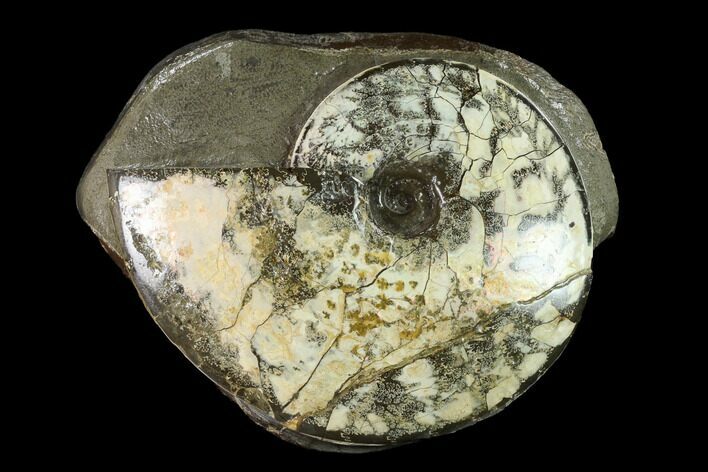This Specimen has been sold.
7.1" Fossil Ammonite (Planticeras) in Rock - South Dakota
This is a large Planticeras meeki ammonite that was collected from the Late Cretaceous age Pierre Shale of South Dakota. Half of it has been prepped free of the hard concretion it was found in. Portions of the shell exhibit gorgeous iridescence.
There is a repaired crack through the ammonite where the rock split during collection. One edge of the specimen is flat, allowing for aesthetic presentation without the need for a display stand.
There is a repaired crack through the ammonite where the rock split during collection. One edge of the specimen is flat, allowing for aesthetic presentation without the need for a display stand.
About These Ammonites
These 70-million-year-old Cretaceous ammonite fossils come from a time when South Dakota was submerged beneath the Western Interior Seaway, a warm, shallow inland ocean that once stretched from the Arctic to the Gulf of Mexico. Ammonites were extinct marine cephalopods related to modern squid, octopus, and cuttlefish, but unlike their soft-bodied relatives, they lived inside coiled, chambered shells. As the animal grew, it added new chambers, using them to regulate buoyancy and move efficiently through the ancient seas. Their abundance and rapid evolution make ammonites some of the most important index fossils for dating marine rocks.
After death, these ammonites settled into seafloor sediments where mineral-rich waters slowly formed concretions around the shells, protecting them from crushing and decay for tens of millions of years. When these stone nodules are split open today, the fossils are revealed locked inside and must be carefully hand-prepared to remove the surrounding rock. This delicate, time-consuming process—often done with air scribes and fine tools—can take many hours per specimen, gradually exposing the shell’s ribs, sutures, and natural curvature. The finished fossils are striking remnants of South Dakota’s ancient ocean, preserving a moment from a world that vanished long before dinosaurs walked on land.
These 70-million-year-old Cretaceous ammonite fossils come from a time when South Dakota was submerged beneath the Western Interior Seaway, a warm, shallow inland ocean that once stretched from the Arctic to the Gulf of Mexico. Ammonites were extinct marine cephalopods related to modern squid, octopus, and cuttlefish, but unlike their soft-bodied relatives, they lived inside coiled, chambered shells. As the animal grew, it added new chambers, using them to regulate buoyancy and move efficiently through the ancient seas. Their abundance and rapid evolution make ammonites some of the most important index fossils for dating marine rocks.
After death, these ammonites settled into seafloor sediments where mineral-rich waters slowly formed concretions around the shells, protecting them from crushing and decay for tens of millions of years. When these stone nodules are split open today, the fossils are revealed locked inside and must be carefully hand-prepared to remove the surrounding rock. This delicate, time-consuming process—often done with air scribes and fine tools—can take many hours per specimen, gradually exposing the shell’s ribs, sutures, and natural curvature. The finished fossils are striking remnants of South Dakota’s ancient ocean, preserving a moment from a world that vanished long before dinosaurs walked on land.
SPECIES
Planticeras meeki
AGE
LOCATION
South Dakota
FORMATION
Pierre Shale
SIZE
7.1" Wide ammonite, entire specimen is 8 x 6.3"
CATEGORY
SUB CATEGORY
ITEM
#143839
We guarantee the authenticity of all of our specimens.
 Reviews
Reviews














